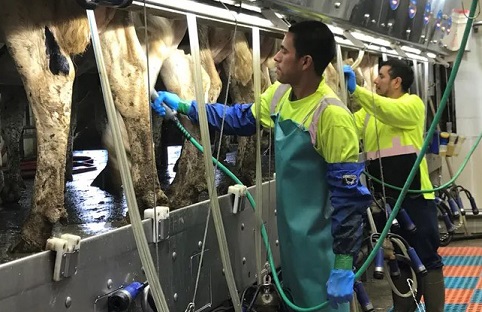Nikhil Prasad Fact checked by:Thailand Medical News Team Oct 05, 2024 7 months, 4 days, 8 hours, 33 minutes ago
H5N1 News: Health officials in California and the Centers for Disease Control and Prevention (CDC) recently confirmed that two dairy workers have contracted bird flu, marking the first human cases in the state amidst an ongoing outbreak affecting dairy farms. The two workers, employed on different farms in California's Central Valley, had direct contact with infected cows. While both experienced mild symptoms such as eye redness, commonly associated with bird flu in humans, neither was hospitalized. This
H5N1 News report will explore the circumstances surrounding the infections and what the findings mean for the general public.
 Bird Flu Spreads to California Dairy Workers Amid Ongoing Outbreak
First Human Cases in California
Bird Flu Spreads to California Dairy Workers Amid Ongoing Outbreak
First Human Cases in California
California is now reporting its first human cases of bird flu, specifically H5N1 avian influenza, which has been plaguing the state's dairy farms. The infections were confirmed by both state and federal health authorities. Notably, the two workers had no known link to each other but worked with infected cows on separate dairy farms. The CDC emphasized that the workers likely contracted the flu from the animals, rather than from human-to-human transmission.
Despite these new cases, health officials maintain that the overall risk to the public remains low. This is largely due to the nature of the virus, which, although it can infect humans, is not easily transmitted between people.
The Bird Flu Outbreak Across U.S. Farms
The bird flu, specifically the H5N1 strain, has been affecting not just poultry but also cattle in various parts of the U.S. for some time. Since the start of 2023, 16 human cases have been recorded across several states, including California, Michigan, Colorado, Texas, and Missouri. However, the outbreak's spread among dairy cows in California is of particular concern due to the state's significant role in the U.S. dairy industry.
As of late August, more than 50 dairy herds in California have tested positive for the virus. The number of infected farms has since risen to 44, with the majority located in California's Central Valley, the heart of the state’s dairy production. Infected herds have been identified through ongoing surveillance efforts to contain the spread of the virus.
Symptoms and Testing of Infected Workers
Both infected dairy workers in California displayed mild symptoms, including eye redness, also known as conjunctivitis. This symptom has been observed in other bird flu cases across the U.S., particularly among livestock workers. Neither of the workers in California experienced respiratory symptoms, which are often more concerning in viral infections.
https://www.cdph.ca.gov/Programs/OPA/Pages/NR24-029.aspx
The first worker tested positive for H5N1 following local laboratory tests, and the CDC later confirmed the results through additional testing. The se
cond worker’s infection was identified after samples were sent to the U.S. CDC, which returned another positive result. Neither worker required hospitalization, and both have since recovered.
Ongoing Investigations and Study Findings
Health officials continue to investigate the origins and spread of the bird flu among dairy herds and its potential to infect humans. Previous studies have shown that although the H5N1 virus can infect humans, such cases are rare and usually limited to individuals who work closely with infected animals. This includes farm workers and those handling poultry or livestock.
Despite this low transmission rate to humans, the continued spread of the virus among dairy herds remains a significant concern. The virus, which was previously mostly associated with wild birds and poultry, now appears to be affecting cows in California, raising new questions about how the virus spreads between species.
Moreover, while the infections in humans so far have been mild, researchers and health officials are paying close attention to any signs that the virus might evolve into a more dangerous form. As with any zoonotic virus (a virus that can spread between animals and humans), there is always a risk of mutations that could make the virus more easily transmissible between people.
Conclusion
The recent bird flu infections among California dairy workers serve as a reminder of the ongoing risks posed by the H5N1 virus, particularly to those working closely with infected animals. While the current risk to the general public remains low, health authorities continue to monitor the situation closely. The outbreak has highlighted the importance of early detection and ongoing surveillance to prevent further spread of the virus.
Despite the low risk to the public, it is crucial that workers in the agricultural sector, especially those in contact with livestock, follow all recommended safety protocols. This includes wearing protective gear and reporting any symptoms promptly. Additionally, the public should remain informed and aware of the situation, although there is no immediate cause for alarm.
As health officials work to contain the spread of bird flu among dairy cows and prevent further human infections, researchers are also studying the virus to better understand its transmission patterns. For now, the general public should feel reassured that the risk of contracting bird flu remains minimal.
For the latest
H5N1 News, keep on logging to Thailand Medical News.
Read Also:
https://www.thailandmedical.news/news/south-vietnam-emerging-as-a-hub-for-a-possible-new-h5n1-strain-as-47-tigers-3-lions-and-a-panther-dies-from-the-virus
https://www.thailandmedical.news/news/new-h5n1-bird-flu-concerns-in-missouri-as-health-care-workers-show-symptoms
